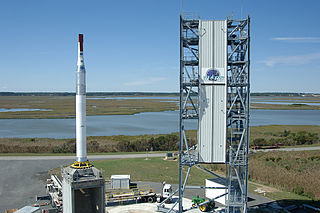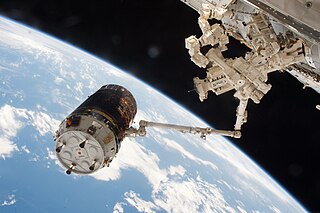Related Research Articles

Soyuz is a series of spacecraft designed for the Soviet space program by the Korolev Design Bureau in the 1960s that remains in service today, having made more than 140 flights. The Soyuz succeeded the Voskhod spacecraft and was originally built as part of the Soviet crewed lunar programs. The Soyuz spacecraft is launched on a Soyuz rocket from the Baikonur Cosmodrome in Kazakhstan. After the retirement of the Space Shuttle in STS-135 (2011), the Soyuz served as the only means to make crewed space flights and the only means to reach the International Space Station until the first flight of SpaceX Crew Dragon Demo 2 on 30 May 2020. The Soyuz is heavily used in the ISS programme.

A CubeSat is a type of miniaturized satellite for space research that is made up of multiple cubic modules of 10 cm × 10 cm × 10 cm size. CubeSats have a mass of no more than 1.33 kilograms (2.9 lb) per unit, and often use commercial off-the-shelf (COTS) components for their electronics and structure. CubeSats are put into orbit by deployers on the International Space Station, or launched as secondary payloads on a launch vehicle. As of 1 January 2021, more than 1350 CubeSats have been launched. More than 1200 have been successfully deployed in orbit and more than 90 have been destroyed in launch failures.

The ballute is a parachute-like braking device optimized for use at high altitudes and supersonic velocities.
The Space Test Program (STP) is the primary provider of spaceflight for the United States Department of Defense (DoD) space science and technology community. STP is managed by a group within the Advanced Systems and Development Directorate, a directorate of the Space and Missile Systems Center of the United States Space Force. But STP is a DoD-wide organization. STP provides spaceflight via the International Space Station, piggybacks, secondary payloads and dedicated launch services.

Mars MetNet is a planned atmospheric science mission to Mars, initiated by the Finnish Meteorological Institute (FMI) and under development by Finland, Russia and Spain. By September 2013, two flight-capable entry, descent and landing systems (EDLS) have been manufactured and tested. As of 2015 baseline funding exists until 2020. As of 2016, neither the launch vehicle nor precursory launch date have been set.

ALV X-1 was the first and only flight of the ATK Launch Vehicle (ALV) sounding rocket developed by Alliant Techsystems. The launch occurred from LP-0B at the Mid-Atlantic Regional Spaceport (MARS) at NASA's Wallops Flight Facility. This mission carried the SOAREX-VI and Hy-BoLT experiments as payloads when it launched at 09:10 GMT on August 22, 2008. The vehicle was terminated 20 seconds into flight after veering too far off course.

NanoSail-D was a small satellite which was to have been used by NASA's Ames Research Center to study the deployment of a solar sail in space. It was a three-unit CubeSat measuring 30 by 10 by 10 centimetres, with a mass of 4 kilograms (8.8 lb). The satellite was lost shortly after launch due to a problem with the rocket carrying it; however, a replacement, NanoSail-D2, was launched in 2010 to complete its mission.

Several new rockets and spaceports began operations in 2016.
Technology Education Satellite (TechEdSat) is a class of CubeSats built by San Jose State University and University of Idaho students in partnership with NASA's Ames Research Center. These satellites have tested communication technology for smallsats, and have contributed to the development of the Small Payload Quick Return (SPQR) concept.

Kounotori 3, also known as HTV-3, is the third Japanese H-II Transfer Vehicle. It was launched on 21 July 2012 to resupply the International Space Station (ISS) aboard the H-IIB Launch Vehicle No. 3 manufactured by Mitsubishi Heavy Industries (MHI) and JAXA. Kounotori 3 arrived at the ISS on 27 July 2012, and Expedition 32 Flight Engineer and JAXA astronaut Akihiko Hoshide used the International Space Station's Canadarm2 robotic arm to install Kounotori 3, to its docking port on the Earth-facing side (nadir) of the Harmony module at 14:34 UTC.

SpaceX CRS-8, also known as SpX-8, was a Commercial Resupply Service mission to the International Space Station (ISS) which was launched on April 8, 2016, at 20:43 UTC. It was the 23rd flight of a Falcon 9 rocket, the tenth flight of a Dragon cargo spacecraft and the eighth operational mission contracted to SpaceX by NASA under the Commercial Resupply Services program. The capsule carried over 3,100 kilograms (6,800 lb) of cargo to the ISS including the Bigelow Expandable Activity Module (BEAM), a prototype inflatable space habitat delivered in the vehicle's trunk, which will be attached to the station for two years of in-orbit viability tests.

Nanoracks LLC is a private in-space services company. Nanoracks is building tools to allow for the re-purposing of in-space hardware and turn it into agile space stations, which the company call Outposts.

PhoneSat is an ongoing NASA project of building nanosatellites using unmodified consumer-grade off-the-shelf smartphones and Arduino platform and launching them into Low Earth Orbit. This project is part of NASA's Small Spacecraft Technology Program and was started in 2009 at NASA Ames Research Center.

Orbital-3, also known as Orb-3, was an attempted flight of Cygnus, an automated cargo spacecraft developed by United States-based company Orbital Sciences, on 28 October 2014. The mission was intended to launch at 22:22:38 UTC that evening. This flight, which would have been its fourth to the International Space Station and the fifth of an Antares launch vehicle, resulted in the Antares rocket exploding seconds after liftoff.

The Nanoracks CubeSat Deployer (NRCSD) is a device to deploy CubeSats into orbit from the International Space Station (ISS).

Kounotori 6 (こうのとり6号機), also known as HTV-6, is the sixth flight of the H-II Transfer Vehicle, an uncrewed cargo spacecraft launched to resupply the International Space Station. It was launched at 13:26:47 UTC on 9 December 2016 aboard H-IIB launch vehicle from Tanegashima Space Center.
Exos Aerospace Systems & Technologies is an aerospace manufacturer and developer of reusable launch systems intended to support unmanned orbital spaceflight launches, and is based in Caddo Mills, Texas.

Schiaparelli EDM was a failed Entry, Descent, and Landing Demonstrator Module (EDM) of the ExoMars programme—a joint mission of the European Space Agency (ESA) and the Russian space agency Roscosmos. It was built in Italy and was intended to test technology for future soft landings on the surface of Mars. It also had a limited but focused science payload that would have measured atmospheric electricity on Mars and local meteorological conditions.
EcAMSat, or E. coli Anti Microbial Satellite, is NASA's first 6U CubeSat, developed to investigate the effects of microgravity on the antibiotic resistance of E. coli. The spacecraft was launched aboard an Orbital ATK Antares rocket from Wallops Flight Facility on 12 November 2017, and was deployed from the International Space Station on 20 November 2017.

NG-13, previously known as OA-13, was the fourteenth flight of the Northrop Grumman robotic resupply spacecraft Cygnus and its thirteenth flight to the International Space Station (ISS) under the Commercial Resupply Services (CRS-1) contract with NASA. The mission launched on 15 February 2020 at 20:21:01 UTC after nearly a week of delays. This is the second launch of Cygnus under the CRS-2 contract.
References
- ↑ Characterizing An Experimental Decelerator For Delivering Nano-Sat Payloads To Planetary Surfaces Kevin Ramus et al., U. of Idaho,
- ↑ The SPQR as an Option for Returning Payloads from the ISS after the Termination of STS Flights Marcus Murbach et al., NASA Ames Research Center,
- 1 2 Exo-Brake Parachute Launched From International Space Station by Keith Cowling, SpaceRef, Nov 2013
- ↑ "TechEdSat-4 (Technological and Educational Nanosatellite-4) - Satellite Missions - eoPortal Directory". directory.eoportal.org. Retrieved 2019-02-23.
- 1 2 "Exo-Brake Enables Safe Return for Small Spacecraft - Tech Briefs :: Aerospace & Defense Technology". www.aerodefensetech.com. Retrieved 2019-02-23.
- ↑ "Wayback Machine" (PDF). 2016-12-29. Archived from the original (PDF) on 2016-12-29. Retrieved 2019-02-23.Cite uses generic title (help)
- ↑ Murbach, Marcus. "TechEdSat 5 / PhoneSat 5 (T5/P5) SmallSat Presentation 2016" . Retrieved 9 September 2018.